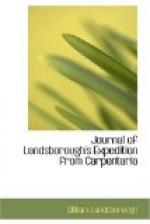March 16.
Today Fisherman and I left the party in camp to ascend the lowest down of the three table ranges on the right bank of the Flinders River. We reached the left bank of the river in a north-north-east direction in about two miles and a half. The river has a sandy level bed which is about eighty yards wide. After crossing the river Fisherman marked a gumtree growing at the bottom of the bank E broad arrow over L. From the river we reached the base of the range in rather less than a mile. I expected to find it of a sandstone formation with triodia on its surface, but on ascending the range I found that, although it had a sandstone formation, it was covered with a dark perforated basalt and at other places with rich soil and good grass. From the summit I observed that the river was joined at a short distance above this range by a tributary to the south-east, and that the following hills bore in the directions named: A high distant table range which I have named after Frederick Walker, Esquire, my brother explorer, 130 degrees; a table range three-quarters of a mile distant 90 degrees; a table range about three miles distant 45 degrees; three conical hills on a range about seven miles distant respectively 44, 43 and 39 degrees; a tent-topped hill about seven miles distant 22 1/2 degrees; a hill with an irregular top about nineteen miles distant 20 degrees; Bramston Range 245 degrees; encampment 195 degrees. After descending the range we proceeded to the junction of the creek and marked trees on both sides of the river just above its junction. Between the hill and the river we found marjoram, a




